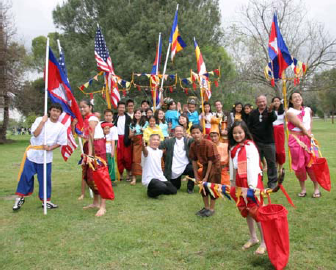
In recent years Trot Dance is becoming popular at the New Year festival. During the New Year festival in 2006, a professor from the University of Phnom Penh in Cambodia came to teach the dance to a group of performers in Long Beach for the celebration at El Dorado Park and the Cambodian New Year Parade along Anaheim Street.
The word Trot is from Sanskrit meaning to end, in this case to end the previous year. Trot is a traditional dance performed in an ancient format believed to ward off bad luck from the previous year. It is usually performed before the New Year festival. [SOT04]
This dance was inherited from the people of Somrae, natives of Cambodia thousands of years ago. During the Angkor era, the people of Somrae performed this dance for the king at New Year celebrations. The dance represents the ending of the old year and brings good luck and prosperity for the king in the coming year. [BUN04]
Trot is connected to a belief that wild animals that come into the village bring bad luck and misfortune. They created Trot which showcase wild animals, allowing villagers to spray perfume, put on makeup, and tie knots on the animals. Then they pray to the animals for good luck. This serves as prevention against bad luck when wild animals come into the village in the future. [SUM04]
There is also a belief that this dance symbolizes the prayer for rain. In this case, they prefer using the peacock tail to represent the sun. The people pray to the sun asking for rain for their farmlands. [SUM04]
The dance originated at a mountain side near the Tonle Sab in the province of Siem Riep. It was studied and performed by the Cambodian International Play between 1955 and 1960, according to the documents from Battambang province. [BUN04] Nowadays, the dance is usually found in Siem Riep and Battambang province. Eventually, additional characters were added--a singer performed as peacock and another singer performed as a spirit with long black nails. [SUM04]
Trot is related to two folktales. The first folktale is about a hunter.
Once upon a time there was a hunter named Bun who lived with his wife name Ubma in Savchey district. One day, the hunter went to hunt as usual but he could not find a single animal. He thought that maybe the forest spirits prevented him from finding the animals, so he prepared an offering and prayer to spirits to help him find animals. Suddenly he came upon a golden deer with golden yellow fur and antlers made out of shiny precious stones. He then shot and killed the deer. Upon retrieving the animal, he realized how beautiful it was and decided to offer it to the king. The king was delighted with the gesture and granted the hunter a rank as the district head. Afterwards, Bun created the Trot dance as a remembrance by making offering to the spirit of the forest. [BUN04]
Another folktale is related to Buddhism. Before Buddha attained enlightenment, he first became a monk. As he was on his way, an evil appears as a golden deer blocks his path. Buddha started to pray to an angel. The angel came down and appeared as a hunter to kill the golden deer and accompanied Buddha on his way to becoming a monk. [BUN04]

The front performer holds a kangcha which is a pole about 2.5 meters in height with the top portion shaped like a fork. The tips of the head are tied together by a string and decorated with dry fruit balls (Angkugn) with metal pieces inside which make noise when the pole is thumb on the ground. This performer provides the beat to the music with other musicians who use drums and two Tros (Tro Ou and Tro Saur - type of instruments used in classical Khmer music).
The Trot song can be heard here: (http://www.cambodianview.com/audio/khmer-traditional-music-robamtrot.rm)
Another song with Trot style sang by Samouth Sin can be heard here: (KamplungLengTrot_Samouth.mp3).
| << New Year Tradition | < Table of Content > | Traditional New Year Games >> |